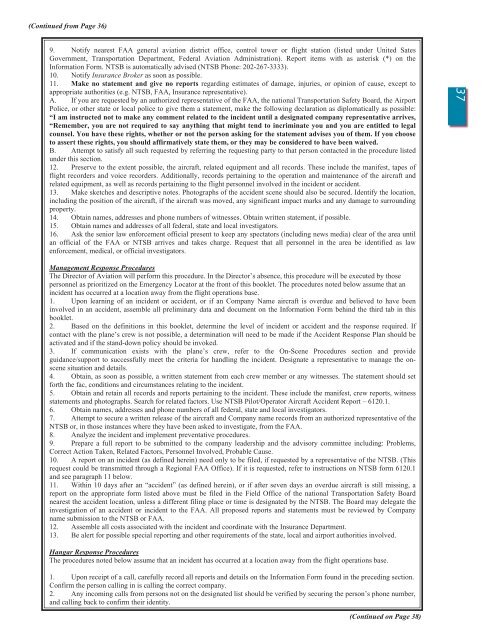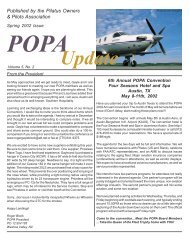Popa - Pilatus Owners and Pilots Association
Popa - Pilatus Owners and Pilots Association
Popa - Pilatus Owners and Pilots Association
You also want an ePaper? Increase the reach of your titles
YUMPU automatically turns print PDFs into web optimized ePapers that Google loves.
(Continued from Page 36)<br />
9. Notify nearest FAA general aviation district office, control tower or flight station (listed under United Sates<br />
Government, Transportation Department, Federal Aviation Administration). Report items with as asterisk (*) on the<br />
Information Form. NTSB is automatically advised (NTSB Phone: 202-267-3333).<br />
10. Notify Insurance Broker as soon as possible.<br />
11. Make no statement <strong>and</strong> give no reports regarding estimates of damage, injuries, or opinion of cause, except to<br />
appropriate authorities (e.g. NTSB, FAA, Insurance representative).<br />
A. If you are requested by an authorized representative of the FAA, the national Transportation Safety Board, the Airport<br />
Police, or other state or local police to give them a statement, make the following declaration as diplomatically as possible:<br />
“I am instructed not to make any comment related to the incident until a designated company representative arrives,<br />
“Remember, you are not required to say anything that might tend to incriminate you <strong>and</strong> you are entitled to legal<br />
counsel. You have these rights, whether or not the person asking for the statement advises you of them. If you choose<br />
to assert these rights, you should affirmatively state them, or they may be considered to have been waived.<br />
B. Attempt to satisfy all such requested by referring the requesting party to that person contacted in the procedure listed<br />
under this section.<br />
12. Preserve to the extent possible, the aircraft, related equipment <strong>and</strong> all records. These include the manifest, tapes of<br />
flight recorders <strong>and</strong> voice recorders. Additionally, records pertaining to the operation <strong>and</strong> maintenance of the aircraft <strong>and</strong><br />
related equipment, as well as records pertaining to the flight personnel involved in the incident or accident.<br />
13. Make sketches <strong>and</strong> descriptive notes. Photographs of the accident scene should also be secured. Identify the location,<br />
including the position of the aircraft, if the aircraft was moved, any significant impact marks <strong>and</strong> any damage to surrounding<br />
property.<br />
14. Obtain names, addresses <strong>and</strong> phone numbers of witnesses. Obtain written statement, if possible.<br />
15. Obtain names <strong>and</strong> addresses of all federal, state <strong>and</strong> local investigators.<br />
16. Ask the senior law enforcement official present to keep any spectators (including news media) clear of the area until<br />
an official of the FAA or NTSB arrives <strong>and</strong> takes charge. Request that all personnel in the area be identified as law<br />
enforcement, medical, or official investigators.<br />
Management Response Procedures<br />
The Director of Aviation will perform this procedure. In the Director’s absence, this procedure will be executed by those<br />
personnel as prioritized on the Emergency Locator at the front of this booklet. The procedures noted below assume that an<br />
incident has occurred at a location away from the flight operations base.<br />
1. Upon learning of an incident or accident, or if an Company Name aircraft is overdue <strong>and</strong> believed to have been<br />
involved in an accident, assemble all preliminary data <strong>and</strong> document on the Information Form behind the third tab in this<br />
booklet.<br />
2. Based on the definitions in this booklet, determine the level of incident or accident <strong>and</strong> the response required. If<br />
contact with the plane’s crew is not possible, a determination will need to be made if the Accident Response Plan should be<br />
activated <strong>and</strong> if the st<strong>and</strong>-down policy should be invoked.<br />
3. If communication exists with the plane’s crew, refer to the On-Scene Procedures section <strong>and</strong> provide<br />
guidance/support to successfully meet the criteria for h<strong>and</strong>ling the incident. Designate a representative to manage the onscene<br />
situation <strong>and</strong> details.<br />
4. Obtain, as soon as possible, a written statement from each crew member or any witnesses. The statement should set<br />
forth the fac, conditions <strong>and</strong> circumstances relating to the incident.<br />
5. Obtain <strong>and</strong> retain all records <strong>and</strong> reports pertaining to the incident. These include the manifest, crew reports, witness<br />
statements <strong>and</strong> photographs. Search for related factors. Use NTSB Pilot/Operator Aircraft Accident Report – 6120.1.<br />
6. Obtain names, addresses <strong>and</strong> phone numbers of all federal, state <strong>and</strong> local investigators.<br />
7. Attempt to secure a written release of the aircraft <strong>and</strong> Company name records from an authorized representative of the<br />
NTSB or, in those instances where they have been asked to investigate, from the FAA.<br />
8. Analyze the incident <strong>and</strong> implement preventative procedures.<br />
9. Prepare a full report to be submitted to the company leadership <strong>and</strong> the advisory committee including: Problems,<br />
Correct Action Taken, Related Factors, Personnel Involved, Probable Cause.<br />
10. A report on an incident (as defined herein) need only to be filed, if requested by a representative of the NTSB. (This<br />
request could be transmitted through a Regional FAA Office). If it is requested, refer to instructions on NTSB form 6120.1<br />
<strong>and</strong> see paragraph 11 below.<br />
11. Within 10 days after an “accident” (as defined herein), or if after seven days an overdue aircraft is still missing, a<br />
report on the appropriate form listed above must be filed in the Field Office of the national Transportation Safety Board<br />
nearest the accident location, unless a different filing place or time is designated by the NTSB. The Board may delegate the<br />
investigation of an accident or incident to the FAA. All proposed reports <strong>and</strong> statements must be reviewed by Company<br />
name submission to the NTSB or FAA.<br />
12. Assemble all costs associated with the incident <strong>and</strong> coordinate with the Insurance Department.<br />
13. Be alert for possible special reporting <strong>and</strong> other requirements of the state, local <strong>and</strong> airport authorities involved.<br />
Hangar Response Procedures<br />
The procedures noted below assume that an incident has occurred at a location away from the flight operations base.<br />
1. Upon receipt of a call, carefully record all reports <strong>and</strong> details on the Information Form found in the preceding section.<br />
Confirm the person calling in is calling the correct company.<br />
2. Any incoming calls from persons not on the designated list should be verified by securing the person’s phone number,<br />
<strong>and</strong> calling back to confirm their identity.<br />
(Continued on Page 38)<br />
37



